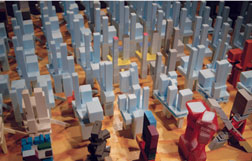 REX |
How many structural engineers does it take to shape a building? Ordinarily, none. That’s the architect’s job. But the $490-million Museum Plaza, smack on an Ohio River flood plain between a levee wall and an elevated highway in Louisville, Ky., is no ordinary job. The site is terrible. The packed, multifaceted program is intertwined. And the project is the most ambitious and audacious to date for its up-and-coming design architect—the one-year-old REX.
The architecture for the 1.6-million-sq-ft Museum Plaza is a “complex synergy between the constraints of economics, structure and layout,” says 37-year-old Joshua Prince-Ramus, who with his 36-year-old partner, Erez Ella, founded the 55-person New York City-based REX.
The raison d’etre of the project is a contemporary art museum. Commercial components such as offices, a hotel, residential lofts and condominiums, retail, part of the University of Louisville and a 450,000-sq-ft parking garage, are intended to help offset the cost of the 50,000-sq-ft museum.
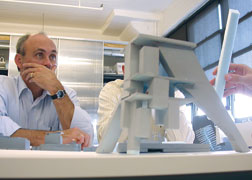 REX
|
 REX
|
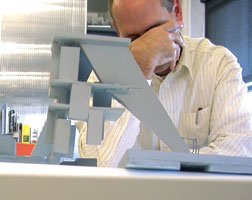 REX
|
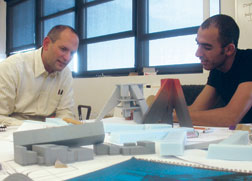 REX
|
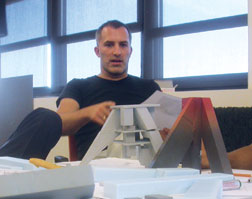 REX Engineers Taylor (first photo from topt) , Klemencic (second and third photo from top), Ella (fourth photo from top) and architects Prince-Ramus (bottom photo)) toy with weird three-legged stool.
|
Most of all, the building is designed to draw people downtown. “We wanted to bring world-class architecture to Louisville,” says Eric Schreiner, president of construction and development for the local Poe Cos.
Poe is one of four development partners in the local Museum Plaza LLC. The others are contemporary art collectors Laura Lee Brown and Steve Wilson, and their lawyer, Craig Greenberg.
In June 2005, with little more than a horrible site bought from the city for $1 and a notion for a multi-use complex, the owner started searching for a design architect. They came upon Prince-Ramus and Ella, then with the New York City branch of the Rotterdam-based Office of Metropolitan Architecture. Prince-Ramus had opened OMA NY in 2000, with his mentor-partner, Rem Koolhaas. In May 2006, Prince-Ramus and Ella bought Koolhaas out of the partnership and formed REX (see p. 32).
In August 2005, Museum Plaza signed on OMA NY. The owner wanted Prince-Ramus and Ella, not for the Koolhaas name but because they were “young and very talented,” says Schreiner. “We wanted someone who hadn’t peaked but was on the way to superstardom.”
The developers were impressed with the architects because of their leadership role on OMA’s wildly eccentric Seattle Central Library, which opened in 2004. “We sensed they were on the cusp of greatness and had the energy we were looking for,” says Schreiner.
The partners would need lots of energy for Museum Plaza. The site is on the wrong side of the tracks, between a rock and a hard place and potentially all wet. Prince-Ramus had no high-rise experience and Ella had very little.
Luckily, REX relishes a challenge. “The office doesn’t do design, it does problem-solving,” says Prince-Ramus.
To solve Museum Plaza’s problems, REX needed a structural engineer not only with skyscraper experience but one it trusted. REX thought of Magnusson Klemencic Associates, Seattle. The name resonated with the owner. “I had had good experiences with MKA on other projects,” says Schreiner, who joined Poe from Hunt Construction in June 2005.
Prince-Ramus and MKA had first worked together on the Seattle library. That project led to other OMA-MKA collaborations. “We’ve had a great relationship with MKA,” says Prince-Ramus. “They understand who we are,” adds Ella. “Sometimes, [as in this case] they bring the idea that shapes the building.”
The respect is mutual. “Josh and I are good friends,” says Jay A. Taylor, MKA’s principal who was the library’s project manager. “He trusts us implicitly.”
| + click to enlarge images | ||
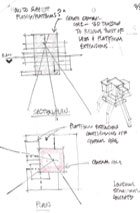 | 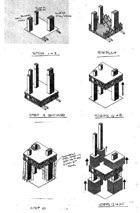 | 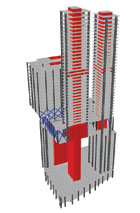 |
| Engineer's sketches for three-legged stool idea and vertical towers with a jacked "island." (images courtesy of MKA)
| ||
The early fall of 2005 was filled with brainstorming sessions between REX and Taylor, MKA’s cultural-building specialist, and Ron Klemencic, MKA’s president and high-rise specialist. “REX wants to understand basic principles of engineering and work the architecture with it,” says Klemencic. “It’s very different from shaping a building and hoping someone can make it stand or doing something wacky for wacky’s sake.”
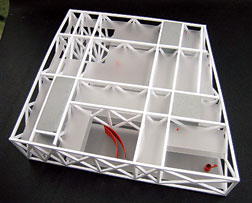 REX Digital model of structure.
|
Working with REX is “liberating,” says Taylor, because time isn’t wasted trying to hide the structure.
The collaborators considered dozens of geometries, as well as their constructibility. “One of the initial ideas was to make the sum of the parts greater than the individual pieces,” says Klemencic.
At the first session at REX, the foursome played with styrofoam blocks. Components were leaning and sloping, with all sorts of contorted shapes. The goal was to balance gravity loads even though the building might be sloping and look radical, says Klemencic.
Soon, the concept of an eccentric three-legged stool took shape, with commercial uses in the legs and the public spaces, amenities, museum and tower lobbies converging under or in the seat, to keep the art out of any flood’s way.
But sloping legs aren’t efficient or economical. So by November 2005, the players had straightened the legs and the stool’s seat had morphed into a “sky island” that would contain the museum, the tower lobbies and public amenities. “The path of balance led to the idea of bracing one building against the other,” says Klemencic.
The straight towers pleased the developer, which wanted to keep them simple to focus on the island. “Our whole project hinges on the design, engineering and cost of the island because it is the most complicated piece,” says Schreiner.
Soon, MKA came up with the idea of building the island on the ground and jacking it nearly 300 ft into place by sliding it up the tower cores. REX jumped on the idea, which would eliminate building so much program in the air.
MKA then ran computer models to explore a space-frame structure for the island, which would span between the towers. By the end of 2005, the construction manager, M.A. Mortenson Cos., Minneapolis, brought on for preconstruction services, had developed a cost estimate which included a $1-million premium for...
 Related Link:
Related Link: 
Post a comment to this article
Report Abusive Comment